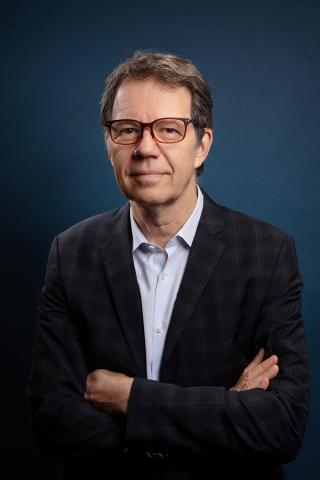Editor's Note:
In the Dialogue with Scientists series, National Business Daily (NBD) examines how the frontiers of discovery are shifting in the wake of the 2025 Nobel Prizes. From molecular design to life’s origins, the conversations with the pioneering minds reveal how modern science advances—not by certainty, but by curiosity and doubt.
CAR T-cell therapy—the idea of re-engineering a patient's own immune cells to seek and destroy cancer—has been hailed as a revolutionary "living drug." Since the first therapies were approved by the FDA in 2017, they have offered new hope to patients with specific blood cancers.
To understand the science behind this breakthrough and its future potential, National Business Daily (NBD) spoke with Dr. Michel Sadelain, a pioneer in the field of CAR T-cell engineering. Dr. Sadelain's work was central to the successful development of the first FDA-approved CAR T-cell therapies.
Dr. Sadelain has won the Breakthrough Prize for Life Sciences, Canada Gairdner International Award, Warren Alpert Foundation Prize, American Society of Gene and Cell Therapy Outstanding Achievement Award, Leopold Griffuel Award, INSERM International Prize, Jacob and Louise Gabbay Award in Biotechnology and Medicine, Passano Laureate, Pasteur Weizmann/Servier Prize at the Academy of Sciences in Paris, Cancer Research Institute Coley Award, Merkin Prize, King Faisal Prize, Broermann Medical Innovation Award, and more.

Dr. Michel Sadelain
The Science Behind the Breakthrough
NBD: For our readers who may not be familiar with it, how would you describe CAR T-cell therapy in simple terms, and why is it considered such a breakthrough in cancer treatment?
Dr. Sadelain: T cells are a critical part of our immune system. They protect us against infections but often fail to eliminate cancer. The CAR T cell technology "instructs" or "teaches" T cells how to recognize and kill cancer cells. This is accomplished by inserting synthetic (artificial) molecules we named CARs into T cells (the process requires transferring a gene coding for the CAR into the T cell). We named these molecules "chimeric antigen receptors" or CARs. We also refer to these cells as “living drugs”, because they live and multiply in the patient's body to fight the cancer.
NBD: Your work is famous for adding a co-stimulatory molecule to the CAR T-cell. Can you explain why this small change made such a big difference in making the therapy effective?
Dr. Sadelain: The CAR molecule has to identify the cancer cell that is to be eliminated and order the T cell to kill the cancer cell. That is however not enough to beat the cancer.
Another critical function of the CAR molecule is to "fuel" the T cell, so it is capable of functioning for a sufficient amount of time. That is why the incorporation of "costimulatory signals" into CARs was so critical to pave the way to success.
NBD: The first CAR T-cell therapies were approved by the FDA in 2017. Can you walk us through what it takes to get a new cancer treatment from the lab to a patient? What are the biggest challenges in that process?
Dr. Sadelain: Here is the timeline: the first CAR incorporating costimulation was published (by us) in 2002; the first successful target molecule, called CD19, which we identified, was published in 2003; the first patient was infused in 2007; the first successful case reports were published in 2011-13; the first 2 CD19 CAR therapies were approved by the US FDA in 2017.
Overcoming Challenges in Cancer and Beyond
NBD: While CAR T-cell therapy has been highly successful for blood cancers like leukemia, it has faced challenges with solid tumors. What makes solid tumors so difficult to treat with this therapy?
Dr. Sadelain: Solid tumors pose additional challenges relative to the leukemias and lymphomas (blood cancers) for which CD19 CAR therapy was developed. Solid tumors differ in their structure. The cancer cells that reside in a tumor mass are surrounded by non-cancerous cells that protect the cancer cells from an immune attack.
The CAR T cells must therefore be instructed to resist or overcome these obstacles. It is also more difficult to find molecules to attack (like CD19 for blood cancers) in solid tumors, because a lot of target molecules identified to date are not present in each and every tumor cell (only some of the tumor cells) or are also present in some normal cells (which causes toxicity).
Nonetheless, I am optimistic that CAR T cells will prevail over some solid tumors in the next years.
NBD: Beyond blood cancers, what other diseases or conditions, besides solid tumors, do you think CAR T-cell therapy could be used to treat in the future?
Dr. Sadelain: While there is much more work to do for cancer (there are many types of cancers), CAR T cells are also likely to be effective in other diseases: in rheumatology (systemic lupus erythematosus, scleroderma, myasthenia gravis and others), in neurology (multiple sclerosis, various forms of neuritis), in transplantation (to prevent graft rejection) and much more.
NBD: You recently moved to Columbia University. What new opportunities or research directions are you excited to explore in your new role at the Columbia Initiative in Cell Engineering and Therapy?
Dr. Sadelain: A large medical school, rather than a specialized center like a cancer center, is better positioned to study all these conditions. Columbia is one of the very best medical schools in the US, embedded in the most densely populated area in the US.

Photo/VCG
The Business and Future of Personalized Medicine
NBD: The cost of CAR T-cell therapy is a major concern for many people. From a business and scientific perspective, what makes this therapy so expensive to produce?
Dr. Sadelain: The high price of commercial CAR T cells may indeed emerge as an obstacle to their broad use and adoption across medical fields. At the current prices that are charged by companies, western health care systems may not sustain the cost of cell therapies for common conditions.
New technologies (robotized procedures or stem cell-derived CAR T cells or in vivo engineering) will reduce the cost; biological improvements will yield better T cells (which in turn will require smaller doses of T cells, and thus decrease the production cost); policy adjustments could also contribute to lower the development and production costs.
NBD: What is the current business landscape of CAR T-cell therapy? What are the next major innovations on the horizon, such as "off-the-shelf" therapies, and what kind of impact could they have on the market?
Dr. Sadelain: There continues to be remarkable innovation in the cell engineering field. New CAR designs, new genetic tools, new production devices, mitigation of toxicities - it is a very vibrant sector.
Investment however has recently diminished, at least in the US. Possibly because of excessive earlier investment in not very robust strategies; possibly because the financial returns are not fast enough or big enough for some investors (more investment has gone to weight loss drugs or AI in recent years).
Irrespective of these market attitudes, the potential of T cell engineering to improve an array of diseases remains enormous.
NBD: Looking back at your career, what was the most surprising or unexpected moment you experienced while developing this revolutionary treatment?
Dr. Sadelain: For many years, leaders in oncology and in industry, as well as classical immunologists, did not believe that the CAR T cell approach could work or could be implemented even if it were successful in clinical trials. They have been proven wrong.
It is gratifying to see past opponents now joining this effort. The most gratifying however is to see all these patients who did not have any therapeutic option and were going to die from their refractory cancer, who are alive thanks to a single infusion of the living drug. CD19 CAR T cells are a prototype for many more medicines in the future.
NBD: What message of hope do you have for patients and their families who are looking for new options in their fight against cancer, and what do you see as the ultimate future of personalized medicine?
Dr. Sadelain: We are just at the beginning of exploring the potential of engineered immunity. It took nearly 30 years (I started working on T cell engineering in 1989) to see the first CAR therapy approved.
The next ones will come much faster. So many brilliant people are working today on T cell engineering (particularly in China)! CAR T cells are a "paradigm shift". This paradigm is new and will evolve in many directions in the very near future.


 川公网安备 51019002001991号
川公网安备 51019002001991号





